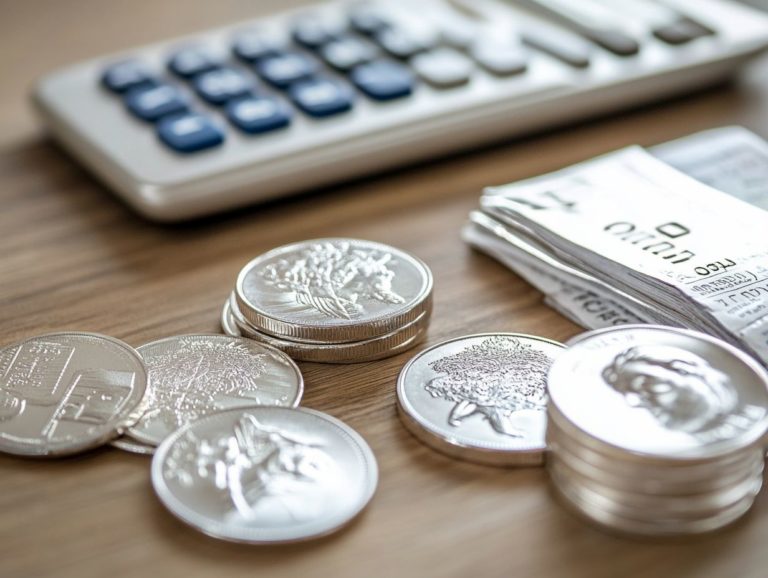5 FAQs About Physical vs. Paper Assets
In the realm of investing, grasping the various types of assets at your disposal is essential for making informed decisions.
This article explores two primary categories: physical assets, such as real estate and precious metals, and paper assets, which include stocks and bonds.
We will also explain the differences between them to help you determine which might be more advantageous for your financial goals. Additionally, we discuss effective strategies for diversifying your portfolio.
We will also explain the associated risks, tax implications, and tactics to safeguard your investments.
Whether you re a seasoned investor or just starting your journey, this guide will help you confidently navigate the complexities of both physical and paper assets.
Contents
- Key Takeaways:
- 1. What Are Physical Assets?
- 2. What Are Paper Assets?
- 3. What Are the Differences Between Physical and Paper Assets?
- 4. Which Is a Better Investment: Physical or Paper Assets?
- 5. How Can One Diversify Their Portfolio with Physical and Paper Assets?
- 6. What Are the Risks Associated with Physical and Paper Assets?
- 7. How Do Physical and Paper Assets Perform During Economic Downturns?
- 8. What Are the Tax Implications of Physical and Paper Assets?
- 9. Can Physical and Paper Assets Be Used as Collateral for Loans?
- 10. How Can One Determine the Value of Physical and Paper Assets?
- 11. What Are the Storage and Maintenance Costs for Physical and Paper Assets?
- 12. How Can One Liquidate Physical and Paper Assets?
- 13. What Are the Advantages and Disadvantages of Physical and Paper Assets?
- 14. How Can One Protect Their Physical and Paper Assets from Theft or Damage?
- 15. Is It Better to Invest in a Mix of Physical and Paper Assets or Stick to One Type?
- Which Type of Asset Is More Resilient to Inflation?
Key Takeaways:

- Physical assets are tangible items like real estate, precious metals, and collectibles that have true worth.
- Paper assets are financial instruments such as stocks, bonds, and mutual funds that represent ownership or debt obligations.
- The main differences between physical and paper assets include their tangibility, liquidity, and potential for appreciation.
1. What Are Physical Assets?
Physical assets, especially gold and bullion bars, represent a tangible category that has been highly valued throughout history for their true worth. They offer a way to keep your money safe during market volatility and economic downturns, making them an appealing option for diversifying your retirement plans.
These assets come in various forms, such as gold coins, bullion bars, and smaller denominations, each with unique advantages. Gold coins, often minted with historical significance, can attract both collectors and investors, while larger bullion bars provide a more straightforward investment in precious metals.
The importance of these assets in your financial portfolio cannot be overstated; they not only act as a hedge against inflation but also contribute to keeping your money safe and potential growth during uncertain times. For those planning their financial futures, incorporating precious metals can enhance stability and serve as protection against economic fluctuations.
2. What Are Paper Assets?
Paper assets, such as gold ETFs (Exchange-Traded Funds that let you buy a basket of stocks at once) and financial contracts, allow you to gain exposure to asset classes like gold without the hassle of physical ownership. This creates unique opportunities and challenges in the current investment landscape.
These paper assets, which also include stocks and bonds, come with varying degrees of liquidity and risk. For example, you can typically buy or sell stocks quickly in the market, while bonds may require longer lock-in periods, affecting your ability to access cash when needed.
ETFs offer diversification, but they also carry market risks stemming from the underlying assets. Unlike tangible assets like real estate or commodities, which tend to retain stable value over time, managing the risks associated with paper assets demands careful consideration of market conditions and your own investment strategies.
3. What Are the Differences Between Physical and Paper Assets?
The key differences between physical and paper assets lie in their nature. Physical gold offers true worth and serves as a secure refuge against the fluctuations of market sentiment, while paper gold exposes you to counterparty risk and economic uncertainties.
As you weigh these differences in your investment strategy, physical gold provides a tangible sense of ownership and acts as a hedge against inflation. It tends to hold its value during economic turbulence, offering reliable protection. However, it comes with challenges, such as storage concerns and the risk of theft.
On the other hand, paper gold boasts greater liquidity and is easier to trade, making it attractive if you seek quick access to your funds. Yet, it s crucial to recognize that this liquidity comes with exposure to market fluctuations and risks associated with financial institutions. This creates a complex decision-making landscape for you as a potential investor, requiring careful consideration of your priorities and risk tolerance.
Ready to explore your options? Let s dive into the world of assets!
4. Which Is a Better Investment: Physical or Paper Assets?
Determining whether physical or paper assets are superior investments often hinges on your individual goals, market trends, and the pursuit of effective diversification strategies within your portfolio.
You must carefully assess a variety of factors, including your risk tolerance, which plays a significant role in the decisions you make in today s dynamic financial landscape. Understanding market sentiment can also grant you valuable insights into timing and potential returns on your investments.
The appeal of tangible assets, such as gold or real estate, often lies in their perceived stability and intrinsic value. In contrast, paper assets, like stocks and bonds, provide convenience and are easy to buy and sell.
Striking a balance between these aspects is essential for crafting robust strategies that align your financial objectives with your personal comfort levels regarding risk and asset management.
5. How Can One Diversify Their Portfolio with Physical and Paper Assets?

Diversifying your portfolio with both physical and paper assets can significantly enhance your financial stability and shield you from market volatility. This strategy allows you to tap into various asset categories, maximizing your potential for value increase.
By incorporating tangible items like gold coins alongside financial instruments such as gold mining stocks or exchange-traded funds (ETFs), you can craft a well-rounded investment strategy.
This approach not only helps mitigate risks tied to market fluctuations. It also addresses any liquidity concerns.
For instance, while physical gold serves as a reliable hedge against inflation, mining stocks can provide you with dividend income and growth potential.
Finding the right balance between these asset types gives you the power to respond adeptly to shifting economic conditions while reaping the rewards of diversification.
6. What Are the Risks Associated with Physical and Paper Assets?
Both physical and paper assets come with their own set of risks that you should be aware of. For paper assets, think market volatility and the risk that the other party in a financial transaction might default. On the other hand, physical assets may present challenges like storage fees and liquidity issues.
Fluctuations in interest rates can particularly impact your paper assets, potentially leading to depreciation in value during economic downturns. Meanwhile, physical assets, like real estate or commodities, may see lower demand, resulting in higher vacancy rates or unsold inventory.
To effectively manage these risks, diversification is key. It helps you reduce exposure to any single type of asset. Regular portfolio assessments and thoughtful asset allocation can further bolster your resilience against market fluctuations, equipping you to navigate the sometimes rocky waters of the economy with greater ease.
7. How Do Physical and Paper Assets Perform During Economic Downturns?
During economic downturns, you ll find that physical assets like gold tend to shine, thanks to their reputation as reliable inflation protectors. In contrast, paper assets can be a bit more temperamental, exhibiting greater volatility and risk depending on the currents of the market.
This historical trend shows that tangible commodities not only preserve value but can also serve as a safe haven for those seeking to safeguard their wealth. On the other hand, paper assets such as stocks and bonds may stumble under economic pressures, potentially leading to losses that can shake your confidence.
To tackle these tough market conditions head-on, savvy investors like yourself often embrace specific strategies, including:
- Diversify your portfolio
- Use options for downside protection
- Consider counter-cyclical investments
By understanding the past performance of both asset types, you can significantly enhance your chances of making informed decisions during turbulent times.
8. What Are the Tax Implications of Physical and Paper Assets?
Understanding the tax implications of both physical and paper assets is essential for you as an investor. Capital gains taxes, particularly within tax-advantaged retirement accounts, can significantly affect your investment returns.
Navigating these nuances gives you the power to make informed decisions about your portfolio. For example, gold, categorized as a collectible, may be subject to higher capital gains tax rates when sold at a profit. Conversely, paper assets like stocks typically enjoy lower long-term capital gains tax rates if held for over a year.
You can implement strategies such as a tax strategy that allows you to offset losses against gains to reduce your taxable income. Additionally, strategically timing the sale of assets to coincide with lower income years can help you significantly reduce your tax bill.
9. Can Physical and Paper Assets Be Used as Collateral for Loans?
Wondering if physical and paper assets can serve as collateral for loans? You’re not alone. Financial institutions tend to take a close look at the liquidity and market value of those assets.
They conduct a thorough evaluation, weighing factors like the asset s current market demand, its historical performance, and the potential for depreciation over time.
For example, physical assets such as real estate or precious metals are often viewed more favorably due to their tangible nature and inherent stability. On the flip side, paper assets like stocks or bonds can pose unique challenges. Their market volatility and liquidity concerns may affect how easily they can be converted into cash during a crisis or market downturn.
Understanding these criteria helps you navigate using assets as collateral more effectively.
10. How Can One Determine the Value of Physical and Paper Assets?

Ready to discover how to value your assets? Let’s dive in and uncover the secrets! Determining the value of both physical and paper assets requires employing specific valuation methods that consider market trends, trading volume, and the potential discrepancies in price that can occur in fluctuating markets.
For example, when you value physical assets like gold, you ll look at factors such as purity, weight, and the current market prices reported by ongoing trades in commodity exchanges. On the other hand, assessing paper assets like stocks typically involves calculations based on earnings multiples a way to assess a company’s value based on its income or discounted cash flow models.
Market sentiment is crucial in both cases; your perception can greatly impact asset prices, often distancing them from their intrinsic values.
An increase in optimism may cause stock prices to soar beyond reasonable metrics, while panic selling can unexpectedly push gold prices down, even though it has a reputation as a safe haven.
11. What Are the Storage and Maintenance Costs for Physical and Paper Assets?
Consider the storage and maintenance costs linked to physical assets! These can greatly impact your investment returns. You should carefully assess these costs as they can significantly affect your overall investment portfolio and profitability.
For instance, the expenses associated with securing gold coins and bullion bars typically include fees for vault storage, insurance, and possibly even transportation. On the other hand, understanding physical vs. paper assets in investing reveals that maintaining paper assets like stocks or bonds generally comes with lower operational costs, primarily revolving around management fees and transaction expenses.
Financial institutions expertly navigate these complexities by providing services that help minimize the risks tied to physical holdings. By striking a balance between these costs, they give you the power to fine-tune your investment strategies while keeping your sights set on potential long-term gains.
12. How Can One Liquidate Physical and Paper Assets?
Liquidating your physical and paper assets demands distinct approaches. The methods you choose can greatly influence both the timing and return on investment.
When it comes to physical assets, factors such as market demand, their condition, and location play pivotal roles in determining how quickly you can sell them and at what price.
On the other hand, for paper assets like stocks and bonds, elements like market conditions, liquidity, and investor sentiment can significantly sway your results.
Employing various selling strategies whether it’s leveraging online auctions for tangible goods or executing tactical trades for securities can be tailored to fit the specific type of asset you re dealing with.
Financial institutions play a crucial role in this landscape, offering insights and services that help you buy and sell assets that streamline these transactions. This ultimately increases your chances of achieving favorable outcomes in both realms.
13. What Are the Advantages and Disadvantages of Physical and Paper Assets?
Each type of asset you encounter, whether physical or paper, brings a unique mix of advantages and disadvantages that can significantly influence your investment strategy and diversification efforts.
Physical assets like real estate or precious metals offer intrinsic value and act as a hedge against inflation. They provide a comforting sense of security for those who prefer tangible investments.
However, keep in mind that they often come with extra costs, such as storage fees and maintenance expenses, which you ll need to factor into your calculations.
In contrast, paper assets, including stocks and bonds, offer higher liquidity, allowing you to enter and exit positions with ease.
Yet, there s a catch: they carry the risk of companies failing to meet their financial obligations, putting your capital at risk if the issuing entity encounters financial trouble.
Striking the right balance between these factors is essential for crafting a robust investment portfolio.
14. How Can One Protect Their Physical and Paper Assets from Theft or Damage?
Protecting your physical and paper assets from theft or damage is essential for safeguarding your investments. Let’s explore some effective strategies to protect your assets.
To effectively mitigate risks, you can implement various methods designed to enhance your security.
For instance, financial institutions are invaluable partners, offering custodial services that ensure your assets are stored securely and shielded from potential losses.
You should also consider safe deposit boxes for your valuable documents or collectibles; these often come equipped with superior security features.
Furthermore, specialized insurance policies can cover a wide range of scenarios, from natural disasters to theft, providing you with the much-needed peace of mind.
Understanding these protective measures now can help you safeguard your investments before it’s too late.
15. Is It Better to Invest in a Mix of Physical and Paper Assets or Stick to One Type?

Deciding whether to invest in a blend of physical and paper assets or to concentrate on a single type hinges on your financial goals and the level of diversification you desire in your investment strategy.
This choice can significantly influence your overall portfolio performance.
Adopting a diversified approach may help mitigate risk and allow you to capture gains across various market conditions.
However, it also requires heightened vigilance and expertise on your part.
Market sentiment plays a crucial role; shifts in the economic outlook can greatly affect the appeal of different asset classes.
Your personal financial situation such as your liquidity needs and risk tolerance will guide whether you lean toward a specialized focus on one asset type or embrace a broader investment strategy encompassing multiple channels.
Carefully weighing these factors is essential for making a well-informed decision.
Which Type of Asset Is More Resilient to Inflation?
In times of inflation, physical assets like gold often stand as a beacon of resilience. They provide a dependable means of preserving value amidst economic turbulence.
This viewpoint is grounded in historical trends showing that tangible commodities maintain their actual worth when currency values waver. Many investors turn to these physical investments like real estate or commodities not just for their actual worth, but also for their potential to appreciate during economic uncertainty, as highlighted in the future of investing: physical vs. paper.
Paper assets may falter under the weight of inflation, as their purchasing power diminishes. Now is the time to consider financial instruments like inflation-linked bonds or diversified asset portfolios. These strategies can effectively safeguard your wealth and help maintain financial stability when it matters most.
Frequently Asked Questions
-
1. What are physical assets?
Tangible items like land, buildings, and equipment.
-
2. What are paper assets?
Intangible assets like stocks and bonds.
-
3. What are the main differences between physical and paper assets?
Physical assets can be used directly; paper assets are more abstract.
-
4. Which type of asset is more stable in value?
Physical assets are generally more stable in value.
-
5. Are physical assets or paper assets better for diversification?
A mix of both is advisable for a robust portfolio.
Consider assessing your investment strategies today or consult a financial advisor to ensure you’re prepared for economic changes.















